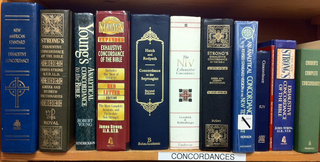
A graphical user interface, or GUI, is a form of user interface that allows users to interact with electronic devices through graphical icons and visual indicators such as secondary notation. In many applications, GUIs are used instead of text-based UIs, which are based on typed command labels or text navigation. GUIs were introduced in reaction to the perceived steep learning curve of command-line interfaces (CLIs), which require commands to be typed on a computer keyboard.

Hypertext is text displayed on a computer display or other electronic devices with references (hyperlinks) to other text that the reader can immediately access. Hypertext documents are interconnected by hyperlinks, which are typically activated by a mouse click, keypress set, or screen touch. Apart from text, the term "hypertext" is also sometimes used to describe tables, images, and other presentational content formats with integrated hyperlinks. Hypertext is one of the key underlying concepts of the World Wide Web, where Web pages are often written in the Hypertext Markup Language (HTML). As implemented on the Web, hypertext enables the easy-to-use publication of information over the Internet.

HyperCard is a software application and development kit for Apple Macintosh and Apple IIGS computers. It is among the first successful hypermedia systems predating the World Wide Web.

In computing, a hyperlink, or simply a link, is a digital reference to data that the user can follow or be guided to by clicking or tapping. A hyperlink points to a whole document or to a specific element within a document. Hypertext is text with hyperlinks. The text that is linked from is known as anchor text. A software system that is used for viewing and creating hypertext is a hypertext system, and to create a hyperlink is to hyperlink. A user following hyperlinks is said to navigate or browse the hypertext.
A translation memory (TM) is a database that stores "segments", which can be sentences, paragraphs or sentence-like units that have previously been translated, in order to aid human translators. The translation memory stores the source text and its corresponding translation in language pairs called “translation units”. Individual words are handled by terminology bases and are not within the domain of TM.
Hypermedia, an extension of the term hypertext, is a nonlinear medium of information that includes graphics, audio, video, plain text and hyperlinks. This designation contrasts with the broader term multimedia, which may include non-interactive linear presentations as well as hypermedia. It is also related to the field of electronic literature. The term was first used in a 1965 article written by Ted Nelson.
A study Bible is an edition of the Bible prepared for use by a serious student of the Bible. It provides scholarly information designed to help the reader gain a better understanding of and context for the text.

A concordance is an alphabetical list of the principal words used in a book or body of work, listing every instance of each word with its immediate context. Historically, concordances have been compiled only for works of special importance, such as the Vedas, Bible, Qur'an or the works of Shakespeare, James Joyce or classical Latin and Greek authors, because of the time, difficulty, and expense involved in creating a concordance in the pre-computer era.
Stuart Moulthrop is an innovator of electronic literature and hypertext fiction, both as a theoretician and as a writer. He is author of the hypertext fiction works Victory Garden (1992), which was on the front-page of the New York Times Book Review in 1993, Reagan Library (1999), and Hegirascope (1995), amongst many others. Moulthrop is currently a Professor of Digital Humanities in the Department of English, at the University of Wisconsin–Milwaukee. He also became a founding board member of the Electronic Literature Organization in 1999.
Search engine indexing is the collecting, and storing of data to facilitate fast and accurate. Index design incorporates interdisciplinary concepts from mathematics, informatics, and computer science. An alternate name for the process, in the context of search engines designed to find web pages on the Internet, is web indexing.
Adaptive hypermedia (AH) uses hypermedia which is adaptive according to a user model. In contrast to regular hypermedia, where all users are offered the same set of hyperlinks, adaptive hypermedia (AH) tailors what the user is offered based on a model of the user's goals, preferences and knowledge, thus providing links or content most appropriate to the current user.

A Bible concordance is a concordance, or verbal index, to the Bible. A simple form lists Biblical words alphabetically, with indications to enable the inquirer to find the passages of the Bible where the words occur.
A web browser is a software application for retrieving, presenting and traversing information resources on the World Wide Web. It further provides for the capture or input of information which may be returned to the presenting system, then stored or processed as necessary. The method of accessing a particular page or content is achieved by entering its address, known as a Uniform Resource Identifier or URI. This may be a web page, image, video, or other piece of content. Hyperlinks present in resources enable users easily to navigate their browsers to related resources. A web browser can also be defined as an application software or program designed to enable users to access, retrieve and view documents and other resources on the Internet.
In philology, a commentary is a line-by-line or even word-by-word explication usually attached to an edition of a text in the same or an accompanying volume. It may draw on methodologies of close reading and literary criticism, but its primary purpose is to elucidate the language of the text and the specific culture that produced it, both of which may be foreign to the reader. Such a commentary usually takes the form of footnotes, endnotes, or separate text cross-referenced by line, paragraph or page.

MicrosoftEncarta is a discontinued digital multimedia encyclopedia published by Microsoft from 1993 to 2009. Originally sold on CD-ROM or DVD, it was also available online via annual subscription, although later articles could also be viewed for free online with advertisements. By 2008, the complete English version, Encarta Premium, consisted of more than 62,000 articles, numerous photos and illustrations, music clips, videos, interactive content, timelines, maps, atlases and homework tools.
The Apostolic Bible Polyglot (ABP), originally published in 2003, is a Bible translation by Charles VanderPool. The ABP is an English translation with a Greek interlinear gloss and is keyed to a concordance. The numbering system, called "AB-Strong's", is a modified version of Strong's concordance, which was designed only to handle the traditional Hebrew Masoretic Text of the Old Testament, and the Greek text of the New Testament. Strong's concordance doesn't have numbering for the Greek O.T. The ABP utilizes a Greek Septuagint base for the O.T. and, therefore, required a modified system. The numbers and the Greek word appear immediately above the English translation instead of side by side, as is common in many interlinears.

Hypertext is text displayed on a computer or other electronic device with references (hyperlinks) to other text that the reader can immediately access, usually by a mouse click or keypress sequence. Early conceptions of hypertext defined it as text that could be connected by a linking system to a range of other documents that were stored outside that text. In 1934 Belgian bibliographer, Paul Otlet, developed a blueprint for links that telescoped out from hypertext electrically to allow readers to access documents, books, photographs, and so on, stored anywhere in the world.

Web navigation refers to the process of navigating a network of information resources in the World Wide Web, which is organized as hypertext or hypermedia. The user interface that is used to do so is called a web browser.

The File Retrieval and Editing SyStem, or FRESS, was a hypertext system developed at Brown University starting in 1968 by Andries van Dam and his students, including Bob Wallace. It was the first hypertext system to run on readily available commercial hardware and OS. It is also possibly the first computer-based system to have had an "undo" feature for quickly correcting small editing or navigational mistakes.

Figurski at Findhorn on Acid is a hypertext novel by Richard Holeton published on CD-ROM by Eastgate Systems in 2001 and republished on the open web by the Electronic Literature Lab, Washington State University, in 2021. Re-Imagined Radio presented a radio interpretation of this novel in 2022 in which Holeton made an appearance. It is a work of interactive fiction with various paths for readers to choose from, an early example of electronic literature, and one of 23 works included in the literary hypertext canon.










